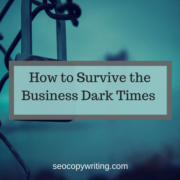Ian Lurie on World Building: Weird, Useful, & Significant
 As an online writer and/or digital marketer, at some point you are sure to come across Portent’s CEO of 20 years, Ian Lurie (if you haven’t already). His wicked sense of humor is matched only by his expertise in all things content and internet marketing.
As an online writer and/or digital marketer, at some point you are sure to come across Portent’s CEO of 20 years, Ian Lurie (if you haven’t already). His wicked sense of humor is matched only by his expertise in all things content and internet marketing.
Here, Ian addresses questions about content visibility beyond the blog, world-building (he loathes the term “content marketing”), and creating “entry points into our world: weird, useful, and significant.”
Hope you enjoy Ian’s interview as much as we did!
In your recent ConfluenceCon presentation you covered a lot of digital marketing ground. One of your main points was about making great content visible beyond the on-site blog.
Specifically, you mentioned using the Open Graph (OG) Protocol and Twitter Cards for social visibility. Could you translate what those are in non-techie speak?
Twitter cards and OGP markup improve the way your content is represented out in the world. In terms of world building, they make the entry points more attractive, and make it more likely that customers will take the first step towards interacting with you.
In practical terms, Open Graph Protocol is something Facebook uses when you embed a link in your newsfeed. Sometimes, when you embed a link, the result includes an image, a site name, etc. The site owner can provide that information to the Facebook crawler using Open Graph Protocol. The more information they provide, the more Facebook can enhance the listing.
In nerdier terms, Open Graph Protocol is a markup standard. It’s code you can embed in a web page that provides additional information, just like meta tags. With it, you can define the page’s topic, title, author, a thumbnail image you’d like displayed when the page is cited and a bunch of other information.
There are also specific OGP attributes you can define for music, videos, products and such.
Twitter cards are similar to OGP. They let you specify images, videos and such that can attach to a tweet of a specific web page. You can link to direct download/install of mobile apps, embed videos, audio, images and thumbnails and set properties like titles, descriptions and the linked site.
You also addressed off-site content marketing, citing SlideShare and free Kindle e-books. What are some general tips for content creators to best leverage these platforms?
It’s all about audience. Use the platform that gives you entry into the biggest, most relevant potential audience. That’s the whole reason for doing it. I know – duh. But when you’re leveraging third party sites, you want to be very, very deliberate about it:
- Make a really good case to yourself for using this or that site
- Understand the upside if your content is super-successful
- Understand what super-successful means on each site
Here are a few examples:
Most people visit the SlideShare for business information. If you want to get visual content in front of millions of business professionals, it’s the place to be. If you don’t have visual content, look elsewhere.
On SlideShare, it’s all about being selected “SlideShare of the Day”. That gets you home page placement, mentions on Twitter by @slideshare and all sorts of other publicity.
LinkedIn owns SlideShare. So success on SlideShare may transfer over to LinkedIn because users can easily share your presentations with their connections.
If that happens, you’ll get lots of visibility. But SlideShare also lets you place lead generation forms in those presentations. I’ve seen that generate leads in the past. Finally, you can let readers download your presentation. That puts your content in a person’s hands, which is great – it’s a permanent invitation to spend more time with you.
SlideShare delivers a very strong, clear invitation to enter your world.
You might write for Medium because you have long-form text content. Medium has a huge audience who come to the site expecting to see great writing in longer format. Medium recommends content to users – play your cards right and you can build real visibility.
There’s no direct business benefit, but Medium is niche-independent. I can make a case for using Medium if I have a unique topic, a non-business topic or a long-form piece in mind and no need for direct lead generation. Medium is the place to make a low-key, sincere invitation to the audience to enter your world and look around on their own.
Finally, look at Kindle e-books. Millions of people monitor Amazon for new free e-books. If you can crack any of the top lists, those people will notice. They can download your e-book and read through it. I’ll use Kindle if I have something text-based in long form and want to create a really lasting impression. Kindle is the rulebook – the detailed map for your audience to enter your world, start learning and really dive deep.
An intriguing part of your presentation is how each marketing campaign is a “little community”, and that we create many “entry points into our world: weird, useful, and significant.” How does a content writer find their “weird” and connect those dots?
You might find “weird” purely instinctively: For instance, I’m a cyclist. I know most cyclists are technology nerds. So I might write something about smartwatches, or the best cell phone cameras (for cyclists who want to take snapshots of that long climb they just did).
You can also find “weird” using tools that dig up random affinities: Ideas, likes and wants linked only by the fact that some people like both. That’s all about collaborative filtering tools.
For example, I love using Amazon’s “people who bought also bought” tool. Did you know people who buy cookbooks are really into de-cluttering (ironic)? Sounds obvious now, but I wouldn’t have thought of it. Or that people who buy diet books also read survival stories and books about direct selling?
And, of course, I hit Facebook a lot. You can use their ads tool to test interest categories and see what Facebook suggests. Before I knew Van Diesel played Dungeons and Dragons, I did a search on D&D and his name popped up. That’s pretty random (by the way, my lifetime ambition is to run a game for him). Also, did you know tennis fans like boxing? I wouldn’t have made that connection.
Collaborative filters aren’t always right. Sometimes they’re hilariously wrong. But they’re a great tool for mining the weird.
In regard to content marketing (“whatever that is”, as you said): what content opportunities are you most excited about right now? Why?
Hmmm. As a writer, I tend to always be excited about content J. No matter what the delivery device, it’s about our ability to effectively communicate. I love it.
But you’re going to ask me again, I bet. So… I’m very excited about this ongoing democratization: Sites like Medium and Netflix delivering their own series and increasingly sophisticated social platforms mean we can engage in some really interesting world building.
Real-time information delivery like Google Now is really exciting, too. I can see some real potential for ‘ambient’ content that provides a great user experience. Imagine being able to stand in a location and ask your phone, “What happened here in 1850?” As a history nerd, I find that pretty exciting because we can curate our environments. That may sound creepy, and chances are marketers will completely trash the concept, but a guy can dream.
So how would you define “content marketing”? Do you have a more accurate definition of what we actually do?
I hate the phrase “content marketing” because it’s become a cliché that refers to cranking out dozens of crappy blog posts. I’ve avoided it because the meaning’s been twisted and over-simplified.
What do we actually do? OK, get ready for some seriously trippy metaphysics:
People are surrounded by content. We’re steeped in it, with clumps and clusters of related content forming worlds around, say, our favorite football team, or the car we want to buy, or childcare advice.
Usually, those worlds are pretty random. We see an article here, a social media post there, a blog post in another place, and then we link them together in our minds.
Content marketing – or whatever you call it – deliberately creates worlds around products or ideas. It creates new content and links it to old, or vice versa, or one or the other. Then it creates points of entry – advertising – to bring people into those worlds. It’s intentional, and it’s immensely powerful.
That’s content marketing. Or, as I call it, world building. I don’t expect that term to ever catch on. It’s too geeky. But I like it. So there.
Connect with Ian on Twitter, LinkedIn and Google+
Want even more SEO content writing goodness? I save the best stuff for my newsletter — sign up here!







Damn, he actually blew my mind with his definition of content marketing at the end. That’s a really interesting way of thinking about it and I totally get it.
Hi Mike! Glad you enjoyed Ian’s interview — he does have a unique perspective on “content marketing” and I appreciate it as well. Thank you :)